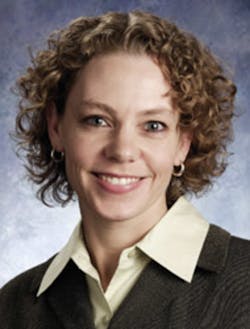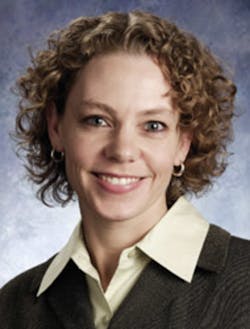Although the evolution of every product offers its manufacturer opportunities to learn important lessons, some products are more instructive than others. At Keithley Instruments, the Model 4200-SCS Semiconductor Characterization System, a sophisticated semiconductor parameter analyzer, has proven to be one of those products.
When introduced to the market in July 2000, the Model 4200-SCS was primarily a DC current-voltage (I-V) device characterization system. Today, to satisfy a growing range of test and characterization needs in an expanding array of disciplines, we’ve evolved the Model 4200-SCS into a system that integrates AC characterization capabilities (multifrequency C-V measurements) and transient measurement capabilities (ultra-fast I-V characterization) with the original DC capabilities.
In 2000, Keithley was a new entrant in the parameter analyzer market. Today, the Model 4200-SCS is the leading solution available. Over the last decade and a half that the system has been in development and on the market, the Model 4200-SCS has taught or reinforced a lot of invaluable lessons to everyone involved in planning, inventing, marketing, and selling it.
Lesson 1: Keep listening to the voice of the customer even after product launch to keep ahead of customer needs.
Keithley uses a variety of techniques to stay tuned in to the needs of the marketplace. One of these is a formal voice of the customer process. Whenever we have a new product concept, we work hard to get input from customer companies all around the world. We want to understand not just what customers want today but also a year or two from now when they are bringing new products to market.
We maintain a database for customer feedback obtained from sales-force visits, interactions with our applications engineers, and contacts at symposia/conferences. We also partner directly with a number of customers to refine product concepts and get their feedback on how we’ve implemented various features and capabilities.
Participation in industry symposia related to our different customer groups has proven to be an invaluable tool for staying in touch; whenever possible, we try to serve in leadership roles in the organizations involved. We are looking to spot trends in technologies and measurements that we think we can or should address effectively. To ensure we stay focused on emerging needs in the market, we have a formalized process in place for gathering insights during a symposium.
We have a written five-year roadmap for the Model 4200-SCS that is updated annually in the form of an action plan. This roadmap is designed to parallel industry technology milestones as laid out in the International Technology Roadmap for Semiconductors (ITRS) and our customers’ individual corporate roadmaps.
Lesson 2: You must lay out the roadmap for the product long before you introduce the first version.
In the 1990s, our market research had informed us that those working in semiconductor labs were typically unhappy with the fixed-configuration characterization systems then available. All too often, they were being forced to purchase a completely new system every few years to address new test needs because their existing ones lacked flexibility.
In response to this market perception, the Model 4200-SCS was specifically conceived as a system that could evolve over time so that we could offer customers a product that protected their instrumentation investment over the long term. To make that possible, the system had to be modular in design, both from an instrumentation perspective and from the controller perspective. To provide an integrated, all-in-one box solution, it needed to incorporate a Windows-based controller. Given the speed with which the Windows platform was evolving, the system had to allow upgrading the embedded controller cost effectively.
To prevent measurement problems that might result from any timing uncertainties, Keithley invested heavily in engineering to ensure that our Windows-based system was reliable and stable, inventing what we called a SmartSMU architecture, which put all the measurement capability, including the timing/triggering, into the instrument itself. In effect, Windows was used simply as a test configuration environment, and the instrumentation performed the measurements independently, then handed the data back to Windows for display and analysis.
All instrument functions were designed as plug-in modules that could be installed in the system’s mainframe/chassis, making it simple for customers to have their systems reconfigured to add more source-measure units (SMUs) or other instruments. This modular design has allowed Model 4200-SCS owners to upgrade their systems cost effectively to address emerging characterization needs. In fact, a Model 4200-SCS owner could return a system purchased in 2000 to the factory today and have it upgraded to include the latest capabilities in the latest version of the software.
Today, the 4200-SCS marketing and development teams remain committed to making certain that new capabilities can be incorporated into existing systems so no one is stuck with an obsolete system that no longer can provide a return on their investment.
Lesson 3: Keep searching for new applications of existing capabilities.
When developing the Model 4225-PMU and 4225-RPM modules that support the Model 4200-SCS’s new ultra-fast I-V capabilities, we had a list of applications in mind, including pulsed I-V testing to prevent device self-heating, CMOS device characterization, nonvolatile memory device testing, compound semiconductor characterization, and NBTI/PBTI reliability testing. However, this functionality has proven so powerful that it is being applied to applications that include characterizing carbon nanotubes (CNTs), semiconductor nanowires, graphene-based devices, molecular-based electronics, MEMS structures, and solar cells.
Over the last decade, we’ve learned researchers far outside the semiconductor lab are using the Model 4200-SCS in some astonishing ways. Just by searching for Keithley 4200 using Google Scholar, we’re constantly discovering the results of research in technologies that simply didn’t exist when the system was introduced.
Lesson 4: Strive to create and share tribal or institutional knowledge about the product throughout the organization.
A long-term development effort like the Model 4200-SCS can’t be just one person’s or one group’s baby, no matter how committed. Corporate leadership, marketing, engineering, manufacturing, sales, and applications groups all must share a common vision of the product and be committed to evolving it to meet new challenges. We’ve built a lot of shared pride about having been a part of the Model 4200-SCS team.
Lesson 5: If you’re developing solutions for a cyclical industry like the semiconductor industry, be prepared to be persistent through its ups and downs.
In a traditional business model, R&D spending is based on the revenues a product is producing; that means many companies tend to cut back on their development investments when there’s an industry downturn. However, companies that abruptly turn off the money spigot when there’s a cyclical downturn simply aren’t in a position to profit from the next market upturn when it arrives. Still worse, they’ve lost credibility with their customers by not being prepared to address their new needs.
One of the things Keithley does, in addition to long-term planning, is to focus on short-term, fast-response projects so that when we spot an industry trend such as organic solar cells that requires specific measurement capabilities, we can address that opportunity very quickly.
Lesson 6: Business development processes must provide visibility into what we’re doing at all levels of the organization.
We’ve found our greatest success in having Model 4200-SCS development projects lead by an engineering project manager and a marketing manager who share responsibility for guiding the efforts of a collaborative, multidisciplinary team. Teams need to bring together a broad cross section of functions including design engineers, applications engineers, manufacturing engineers, and marketers to develop a solution quickly that fits customers’ needs precisely. We’ve also found it helpful to arrange for our design engineers to visit customers so they can hear the voice of the customer first hand.
Lesson 7: Make sure that first bite isn’t more than you can chew.
The first two product concepts for the Model 4200-SCS, which were based in part on input from customer focus groups, didn’t receive top management approval. Quite simply, their scope was too large to succeed in a reasonable time—it was just too big of a bite. Despite the undeniable value of their insights, customers in focus groups often have no concept of what it takes to bring a sophisticated system of this type to market.
For Keithley, the approach that ultimately proved successful was to create a description of the initial offering that was doable yet still focused on the most important customer priorities uncovered in the focus groups. This was followed by a priority list of other nice-to-have features that would be implemented over time.
Conclusion
A development project of the scope of the Model 4200-SCS is always a learning experience. The lessons this product has taught us are already shaping how we approach the next generation of system upgrades as well as the process of developing products for new test and measurement challenges.
About the Author
Linda Rae is president of Keithley Instruments, responsible for managing the ongoing operations of the company and overseeing the engineering, marketing, sales, manufacturing, quality, HR, and IT departments. Ms. Rae joined Keithley in 1995 as a product marketer. She holds a B.S. in electrical engineering from the University of Florida and an M.S. in electrical engineering and an M.B.A. from Case Western Reserve University.
Keithley Instruments, 440-248-0400, [email protected]

